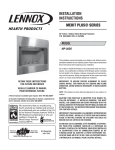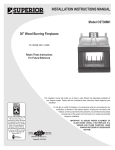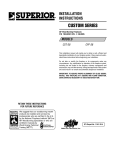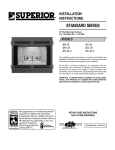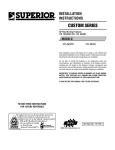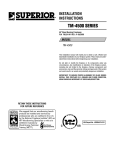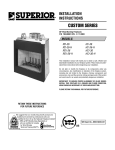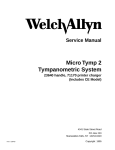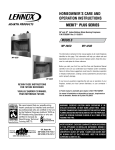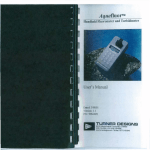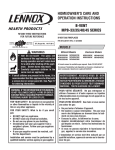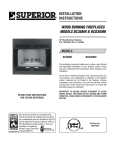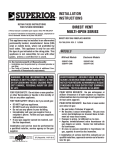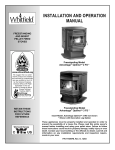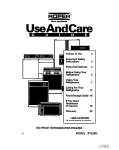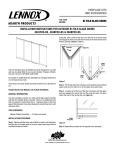Download LG MP-42OD User's Manual
Transcript
INSTALLATION INSTRUCTIONS MERIT® PLUS SERIES 42" Indoor / Outdoor Wood Burning Fireplaces P/N 850,031M REV. B 04/2006 MODEL MP-42OD This installation manual will enable you to obtain a safe, efficient and dependable installation of your fireplace system. Please read and understand these instructions before beginning your installation. Do not alter or modify the fireplace or its components under any circumstances. Any modification or alteration of the fireplace system, including but not limited to the fireplace, chimney components and accessories, may void the warranty, listings and approvals of this system and could result in an unsafe and potentially dangerous installation. RETAIN THESE INSTRUCTIONS FOR FUTURE REFERENCE VEUILLEZ GARDER CE MANUEL POUR RÉFÉRENCE FUTURE. A French manual is available upon request. Order P/N 850,031CF Ce manuel d’installation est disponible en francais, simplement en faire la demande. Numéro de la pièce 850,031CF. IMPORTANT! TO ASSURE PROPER ALIGNMENT OF GLASS DOORS: INSTALL THIS FIREPLACE IN A SQUARE AND PLUMB CONDITION, USING SHIMS AS NECESSARY AT SIDES AND/OR BOTTOM. NOTE: This fireplace has been listed and approved for use outdoors or indoors. CAUTION! THIS FIREPLACE IS EQUIPPED TO BE READILY INSTALLED OUTDOORS. IF INSTALLED INDOORS, YOU MUST INSTALL THE COMBUSTION AIR COVER PROVIDED WITH THE INSTALLATION KIT OR PURCHASE THE OPTIONAL OUTSIDE AIR KIT GATE OAKG-OD. SEE INSTRUCTIONS INSIDE THIS MANUAL FOR FURTHER DETAILS. IMPORTANT! POUR ASSURER L’ALIGNEMENT APPROPRIÉ DES PORTES DE VERRE : INSTALLEZ CE FOYER SUR UNE SURFACE PLANE ET METTRE À NIVEAU EN UTILISANT DES CALES AU BESOIN SUR LES CÔTÉS OU EN DESSOUS. OTL Report No. 116-F-37-2 ATTENTION! CETTE CHEMINÉE A ÉTÉ ÉNUMÉRÉE ET APPROUVÉE POUR ÊTRE AISÉMENT INSTALLÉE À L’INTÉRIEUR OU DEHORS. S’INSTALLÉ À L’INTÉRIEUR, VOUS DEVEZ INSTALLER LA COUVERTURE D’AIR DE COMBUSTION ÉQUIPÉE DE KIT D’INSTALLATION OU ACHETER LA PORTE EXTÉRIEURE FACULTATIVE OAKG-OD DE KIT D’AIR. VOIR LES INSTRUCTIONS À L’INTÉRIEUR DE CE MANUEL POUR D’AUTRES DÉTAILS. TABLE OF CONTENTS Safety Rules ......................................Page Tools and Building Supplies ..............Page Precautions .......................................Page Introduction ......................................Page Clearances/Height Requirements ......Page Chimney System ...............................Page Assembly Outline ..............................Page Location of Fireplace .........................Page Clearances ........................................Page Assembly Steps ................................Page Preinstallation Notes .........................Page Waterproofing Fireplace ....................Page Outside Air Kit .................................Page Fireplace & Framing Specifications ...Page Installing the Fireplace ......................Page Installing the Chimney System ..........Page 30° Offset through Floor/Ceiling .......Page Ten Foot Rule Summary ....................Page Multiple Terminations .......................Page Chimney Component Calculations ....Page Special Offset Instructions ................Page Offset Calculations ............................Page Vertical Elevation Charts ..................Page Installing Offsets ...............................Page Offset Elevation Chart........................Page Gas Line Connection .........................Page Vent Free Appliances .........................Page Glass Doors ......................................Page Cold Climate Insulation .....................Page Fireplace Finishes - Mantels and Trim ..Page Hearth Extensions/Wall Shields ........Page Finish Requirements .........................Page Installation Components ...................Page 2 2 2 3 4 4 4 5 5 6 6 6 6 9 10 12 13 15 15 15 15 16 15 16 18 18 19 19 20 20 20 22 23 PACKAGING The assembled indoor/outdoor fireplace is packaged with: 1 - One envelope containing the literature package which consists of the homeowner's manual, installation instructions, warranty and combustion air cover (located in the firebox). 2 - One Outside Air Kit. 3 - Hearth Extension Strips. PLEASE READ AND UNDERSTAND THESE IMPORTANT SAFETY RULES. WARNING To avoid the risk of damaging fireplace materials and increasing the risk of fire, do not use the fireplace to cook or warm food. 2 AVERTISSEMENT Pour éviter le risque d’endommager les matériaux du foyer et d’augmenter le risque d’incendie, n’employez pas le foyer pour faire cuire ou réchauffer de la nourriture. 1. Before starting your fireplace installation, read these installation instructions carefully to be sure you understand them completely and in entirety. Failure to follow them could cause a fireplace malfunction resulting in serious injury and/or property damage. 2. Always check your local building codes. The installation must comply with all local, regional, state and national codes and regulations. 3. This fireplace must be installed with Security Chimneys FTF8 [8" (203mm) inside diameter] Chimney System only. This fireplace is intended for indoor or outdoor installations. The chimney system must always vent to the outside of the building or structure. 4. To ensure a safe fireplace system and to prevent the build-up of soot and creosote, inspect and clean the fireplace and chimney prior to use and periodically during the heating season. 5. Burn approved fuels only as defined in the Homeowner's Care and Operation Manual. 6. NEVER use gasoline, gasoline-type lantern fuel, kerosene, charcoal lighter fluid, or similar liquids to start or “freshen up” a fire in this fireplace. Keep any flammable liquids at safe distance from the fireplace. 7. NEVER leave children unattended when there is a fire burning in the fireplace. 8. Always keep flue damper open when heat is present in the fireplace. 9. Before servicing, allow the fireplace to cool. Always shut off any gas to the fireplace while working on it. This will prevent the possibility of burns. 10.This fireplace is not a heater. It is designed to ensure homeowner comfort by providing supplemental heat to its immediate area. 11. Keep screens closed after feeding fire to keep embers from flying out ot fireplace. 12.INDOOR INSTALLATIONS: • Always ensure that an adequate supply of replacement combustion air from the outside of the house is accessible to the fire to support normal combustion. Fireplaces consume large volumes of air during the normal combustion process. • In the event the home is tightly sealed with modern energy efficient features, the optional outside air kit may not provide all the air required to support combustion. NOTE: DIAGRAMS & ILLUSTRATIONS ARE NOT TO SCALE. • The manufacturer is not responsible for any smoking or related problems that may result from the lack of adequate combustion air. It is the responsibility of the builder/contractor to ensure that adequate combustion air has been provided for the fireplace. • An Outside Air Cover (provided) or an Outside Air Kit Gate, model OAKG-OD (optional) must be installed to prevent significant cold air infiltration. 13.Always ensure that the air inlet to the fireplace is free from debris and any other obstructions that can block the entrance of air. 14.DO NOT use a fireplace insert or any other product not specified by Lennox for use with this fireplace. All gas log sets must be operated with the damper clamped open, including unlisted “vent free” log sets. Listed “vent-free” log sets may be operated with the damper closed. 15."Smoke free” operation is not warranteed nor are we responsible for inadequate system draft, general construction conditions, inadequate chimney heights, adverse wind conditions and/or unusual environmental factors or conditions beyond our control. 16.Never, under any circumstances, install a fireplace, chimney component or any accessories, that has visible or suspected physical damage as a result of handling or transportation. These items should be inspected by your distributor or qualified factory representative to ensure safe condition. When in doubt, consult your distributor. 17.For additional safety considerations and complete operating instructions, refer to the Care and Operation Manual provided with the fireplace. TOOLS AND BUILDING SUPPLIES NORMALLY REQUIRED Tools Supplies Phillips screwdriver Hammer Saw and/or sabersaw Level Measuring tape Plumb line Electric drill and bits Pliers Square Framing materials Wall finishing materials Caulking materials (noncombustible) Fireplace surround and hearth extension materials (noncombustible) PRECAUTIONS The most important areas of concern dealing with the installation of factory-built fireplaces are clearances to combustible materials, proper assembly of component parts, height of the chimney system, the proper use of accessories supplied by the manufacturer and the techniques employed in using finishing materials applied to the wall surrounding the fireplace, hearth extensions and wall shields. Each of these topics will be covered in thorough detail throughout this manual. Please give each your special attention as you progress with your installation. Note: These fireplace systems are not difficult to install. However, in the interest of safety, it is recommended that the installer be a qualified or certified “tradesman” familiar with commonly accepted fireplace installation and safety techniques as well as prevailing local codes. INTRODUCTION General Information These fireplaces are traditional radiant heat fireplaces with standard bar grates, optional Outside Air Kits (required for outdoor installations) and optional Operable Bi-Fold Stainless Outdoor Glass Doors and Weather Cover. These appliances are approved for installation indoors or outdoors. Indoors: These appliances are approved for installation in residential homes and other buildings of conventional construction including commercial, not in manufactured homes(see Figure 5). Outdoors: These appliances are approved for installion against an outside wall of a house, or as a freestanding fireplace on the porch, patio, or located in the yard (see Figure 6). The Outdoor Fireplace must be enclosed to prevent impact damage to the outside of the fireplace. Build an outside enclosure out of standard building materials, being careful to maintain the minimum air clearances specified in these Installation Instructions. When installing the fireplace as a freestanding unit on your porch, patio or backyard, it must also be enclosed to prevent impact damage to the fireplace. However, the enclosure must now be finished on all four (4) sides. The exterior of the enclosure may be finished in a textured plywood, a wood clapboard siding, brick, or a cultured stone. Vinyl siding is not recommended for use on the front of the fireplace due to the heat the unit produces. This can cause the vinyl siding to deteriorate. Note: Illustrations shown reflect “typical” installations with nominal dimensions and are for design and framing reference only. Actual installations may vary due to individual design preferences. However, always maintain minimum clearances to combustible materials and do not violate any specific installation requirements. These fireplaces have been tested and listed by OMNI-Test Laboratories, Inc. (Report No. 116-F-37-2) to U.L. 127 (USA) and U.L.C. S610 (Canada). These units are intended for indoor and outdoor installations as specified in this manual. For installations in Canada, the chimney clearance to combustibles must be 2 inches and the Cold Climate Kit must be installed. WARNING Do not pack or fill required air spaces with insulation or other material. No material is allowed in these areas. AVERTISSEMENT Ne remplissez pas les espaces libres d’une matière isolante ou de tout autre type de matériel. Aucun matériel n’est permis dans ces espaces vides. WARNING If insulation is used, the fireplace must not be placed directly against it. Insulation or vapor barriers, if used, must first be covered with gypsum board, plywood, particle board or other material to assure insulation and vapor barriers remain in place. AVERTISSEMENT Si un isolant est utilisé, il ne doit pas venir en contact avec le foyer. L’isolant ou le coupe vapeurs, si utilisée, doit d’abord être couvert d’un panneau de gypse, contreplaqué, panneau de particules ou d’un autre matériel pour s’assurer que l’isolant et le coupe vapeurs demeurent en place. These fireplace systems are designed for installation in accordance with the National Fire Protection Standard for chimneys, fireplaces and solid fuel burning appliances; NFPA 211-latest edition and in accordance with codes such as the BOCA Basic/National Codes, the Standard Mechanical Code and the Uniform Building Codes. TYPICAL INSTALLATION - INDOORS TYPICAL INSTALLATION - OUTDOORS Termination (FTF8-CTDTM) Chimney and Termination Storm Collar (FSC) Flashing (Locally Fabricated) Chimney Section (FTF8-48) * Outside Air Kit (provided) must be installed in outdoor installation. Use Only Non-Combustible Materials From Top Of Spacers Down (5" Min.) And Within 1/2" Min. To Side Frame. Metal Safety Strips And Hearth Extension Required When Installed On Combustible Floor Or In Proximity To Combustible Floor/Covering. Figure 1 Outdoor fireplace system less than 15 feet height must have a chimney clearance of 2” air space to insulation and construction materials and be a minimum of 10 feet away from a building or combustible structure. If installed closer than 10 feet, the 10 foot rule applies (see ten foot rule summary on Page 15). Outside Air Kit installation is optional unless mandated by local building codes. Outside Combustion Air Kit (Optional) 7' 9" Min. (using one 4' section) *Air Inlet (Provided) Notes: • Framing is shown as reference only. It can differ according to design and local building codes. • Fireplace is shown for illustration purposes only. It may differ from actual model. Note: Framing is shown as reference only. It can differ according to design and local building codes. NOTE: DIAGRAMS & ILLUSTRATIONS ARE NOT TO SCALE. Note: Framing and fireplace shown as reference only. It can differ according to design and local building codes. Figure 2 3 WARNING Failure to use manufacture provided parts, variations in techniques and construction materials or practices other than those described in this manual may create a fire hazard and void the limited warranty. AVERTISSEMENT L’échec d’utiliser la fabrication les parties fournies, les variations dans les techniques et le matériel de construction ou les pratiques autre que ceux-là ont décrit dans ce manuel peut créer un risque d’incendie et un vide la garantie limitée. When complete these fireplace systems consists of five basic “sub-systems”: 1. The Fireplace 2. The Chimney and Termination 3. The Optional Glass Doors 4. The Optional Outside Air Kits 5. The Optional Weather Cover (for outdoor installations) CLEARANCES AND HEIGHT REQUIREMENTS The fireplace may be placed on or near normal construction materials*. The outside air kit, firestop spacer and roof flashing (not chase flashings) may be placed directly on or against normal construction materials. ** A combustible mantel may be installed 12" above the opening of the fireplace as per NFPA 211-latest edition. In Canada, the minimum is 18" above the fireplace opening. * In the USA, the chimney and fireplace outer wrapper require a minimum 1" air space to insulation and construction materials. * Outdoor installations less than 15’ height require chimney clearance of 2” air space to insulation and construction materials. INDOOR INSTALLATIONS - The minimum installed height of the completed fireplace system for is 15' 0." The maximum height is 60' 0" (see Table 1). OUTDOOR INSTALLATIONS - The minimum installed height of the completed fireplace system is 7' 9." The maximum height is 60" (see Table 2). Outdoor installations less than 15’ height require chimney clearance of 2” air space to insulation and construction materials. The fireplace and chimney system must be enclosed when installed in or passing through a living area where combustibles or people may come in contact with it. This is important to prevent possible personal injury or fire hazard. For questions, please call your distributor or the manufacturer. Special restrictions apply to the front and facing of the fireplace and nearby walls (See Pages 20, 21 & 22). CHIMNEY SYSTEM These fireplaces are designed and code listed for use with Security Chimneys FTF8 chimney System only. Always use Security Chimneys FTF8 chimney components with these fireplaces. Do not modify or alter these components as this may cause a potential serious hazard and void the Warranty. Chimney Height - Indoor Installations The total height of your completed fireplace system from the surface the fireplace rests on to the chimney top must not exceed 60' and must also meet minimum height requirements. Refer to the minimum system height chart (see Table 1). Chimney Height - Outdoor Installations The total height of your completed fireplace system from the surface the fireplace rests on to the chimney top must not exceed 60' and must also meet minimum height requirements. Refer to the minimum system height chart (see Table 2). INDOOR INSTALLATIONS Minimum System Height Security's FTF8 Pipe Vertical Installation 15' 0" One Offsets 15' 0" Two Offsets 25' 0" Table 1 * In Canada, the chimney and fireplace outer wrapper require a minimum 2" air space to insulation and construction materials. ** Construction Materials: • Framing Materials • Paneling • Particle Board • Flooring • Dry Wall • Plywood • Noncombustible Insulating Materials • Etc. 4 OUTDOOR INSTALLATIONS Minimum System Height Security's FTF8 Pipe Vertical Installation 7' 9" One Offsets 15' 0" Two Offsets 25' 0" Table 2 - See following Notes NOTE: DIAGRAMS & ILLUSTRATIONS ARE NOT TO SCALE. Notes (Table 2) • Outdoor fireplace system less than 15 feet height must have a chimney clearance of 2” air space to insulation and construction materials and be a minimum of 10 feet away from a building or combustible structure. The 10 foot rule applies on all cases (see ten foot rule summary on Page 15). • The system height may be reduced to a single length of FTF8-48 pipe and termination with the FTF8-CTDTM for a minimum height on a complete system of 7' 9." The fireplace must be installed as a Freestanding system and located a minimum of 10' away from any building or structure (refer to Figure 1). • The minimum height will vary when using other Firecraft or Lennox Terminations. Chase Enclosure A chase is a vertical box-like structure constructed to surround the fireplace and chimney. Refer to Figure 4 for a typical chase configuration. As with all chimney installations, avoid overhead obstructions such as trees, power lines, etc. A chase should be constructed and insulated just like any outside wall. In a cold climate, we recommend the base of the chase should also be insulated between the solid continuous floor beneath the fireplace and the chase bottom. Chase insulation in a cold climate installation is not required for safety. Note: Do not insulate the chase cavity with blown or fill type insulation materials. Note: Local codes may not require firestopping at the ceiling levels for outside chase installations. However, it is recommended for safety and the reduction of heat loss. ASSEMBLY OUTLINE Before You Start Check your inventory list to be sure you have all the necessary parts supplied in good usable condition. Check also for any concealed damage. Check the operation of the damper. The damper is controlled through the use of a control lever located within the firebox opening at the top center in front of the firebox lintel (Figure 3). The control lever snaps into place at either extreme of its range of motion. When locked in position all the way to the right, the damper is open. When locked in position all the way to the left, the damper is closed. Indoor Locations - Carefully consider the position of the fireplace opening with respect to the location of adjacent or nearby stairwells, bath or kitchen exhaust fans and/or return air registers for forced air furnaces/air conditioners that could cause a smoking fireplace condition if the house is tightly insulated. Damper Open Damper Closed Lintel Combustion Air Actuator (when installed) When choosing a location, care must be taken to avoid places where flooding or running water may be a problem. DO NOT place furniture or other items such as plants or decorative objects within 60” of the fireplace front face. Outdoor Locations - Top View LIVING SPACE Indoor Locations - Top View Figure 3 Chase Enclosure - Indoor Installation Insulate Joists Same As Ceiling Air Inlet (inlet must be free of any obstructions) Optional Hearth Extension Hearth PATIO Hearth Draft Stops Figure 6 Figure 5 Optional Outside Chase Firestop CTDT Termination CAUTION Note: NonCombustible Chase Flashing Must Be Used To Cover Chase Opening Optional Insulation In Outside Walls Of Chase To ensure that the outside air kit remains open for an outdoor installation, this fireplace should not have a combustion air gate control installed (OAKG-OD). If this unit is installed indoors, you must install the outside combustion air cover provided or an optional outside air kit gate (OAKG-OD) before the fireplace is framed in place. 8' Level Solid Continuous Surface Insulation (Thermal Barrier) Outside Base Figure 4 LOCATION OF FIREPLACE Carefully select the proper location for heat circulation, aesthetics, chimney obstructions, air inlet location and clearance to side wall(s). With proper pre-planning, a slight adjustment of a few inches can save considerable time and expense later during construction and assembly. See Figures 5 & 6 for examples. When locating the fireplace, consideration must be given to combustibles and final finishing. See Figure 5 and confine the final location of combustible finish materials to the "Safe Zone." DO NOT permanently place furniture or other items such as decorative pillows within 60" of the fireplace front face. ATTENTION Assurer que les restes extérieurs de kit d’air ouverts pour une installation extérieure, cette cheminée n’ont pas une commande de porte d’air de combustion a installé (OAKG-OD). Si cette unité est installée à l’intérieur, vous devez installer la couverture extérieure d’air de combustion fournie ou une porte extérieure facultative de kit d’air (OAKG-OD) avant que la cheminée soit encadrée en place. Restrictions for Outdoor installations: • Outside Air Kit must be installed and fully open on the outdoor installation. On the indoor installation is optional unless mandated by local building codes. • Minimum chimney height for the outdoor installation is 7' 9" (one 4 foot pipe section). • Minimum 2" chimney clearance is required when system height is less than 15'. • Only non-combustible materials are allowed on the front face (Front Fireplace Frame) and around the perimeter within 5” (full length of top spacers) on the top and 1/2" on the sides (see Figures 1, 51 & 52). Combustible materials may project beyond the sides of the fireplace opening as long as they are kept within the shaded areas illustrated in Figure 7. CLEARANCES Minimum clearance to combustibles for the appliance is as follows: sides and back - 1” (25 mm), floor - 0” (0 mm), adjacent wall - 12” (305 mm), ceiling - 37 1/2” (953 mm). Note: Clearance at the nailing tab is 0" (0mm) (see Figure 25). Note: Adjacent wall considerations are for an adjacent wall on only a single side. Walls should not be placed at minimum distance at both sides of the fireplace. Frame Surface Not to Be Covered With Combustible Materials Wall 12" Covering 45° 1" Outdoor Locations - Carefully consider the position of the fireplace opening with respect to the location of adjacent or nearby stairwells, doors, windows, walk ways and over hanging trees, patios and wires. NOTE: DIAGRAMS & ILLUSTRATIONS ARE NOT TO SCALE. Door Opening 12" Safe Zone Figure 7 Clearances 5 ASSEMBLY STEPS Note: The following steps represent the normal sequence of installation. Each installation is unique, however, and might require a different sequence. 1. Position firebox prior to framing or into prepared framing. 2. (Outdoor Installations) Waterproof the fireplace. See Waterproofing The Fireplace on Page 6. 3. Install the chimney system. 4. Install an outside air cover or an airgate kit, if fireplace is being installed indoors (optional accessory, see Page 23 for ordering information). The Airgate kit is required on all INDOOR installations when an outside air kit is installed. The Airgate Kit is NOT approved for use on outdoor installations. 5. Install outside air kit (provided). This kit is required on ALL outdoor installations (optional for indoor installations). 6. Plumb gas line if a decorative gas appliance will be used. (Gas connections should only be performed by an experienced, licensed/ certified tradesman). 7. Complete the installation, finish wall material, surround and hearth extension to your individual taste. 8. Assemble and attach optional glass door assembly. Study the illustration of the installation, Figures 1 & 2, to get a general idea of each element of your fireplace system. PRE-INSTALLATION NOTES The fireplace may be installed directly on a combustible floor or raised on a platform of an appropriate height. Do not place fireplace on carpeting, vinyl or other soft floor coverings. It may, however, be placed on flat wood, plywood, particle board or other hard surfaces. Be sure fireplace rests on a solid continuous floor or platform with appropriate framing for support (and for indoor installation ensure that no cold air can enter the room from under the fireplace). The fireplace may be positioned and then the framing built around it, or the framing may be constructed and the fireplace positioned into the opening. Usually, no special floor support is needed for the fireplace, however, to be certain: 6 1. Estimate the total weight of the fireplace system including chimney and surround materials such as brick, stone, etc., to be installed. Shipping weight for the fireplace may be found on Page 9 (see Product Reference Information). 2. Measure the square footage of the floor space to be occupied by the system, surrounds and hearth extensions. 3. Note the floor construction, i.e. 2 x 6’s, 2 x 8’s or 2 x 10’s, single or double joists, type and thickness of floor boards. 4. Use this information and consult your local building code to determine if you need additional support. If you plan to raise the fireplace and hearth extension, build the platform assembly then position fireplace and hearth extension on top. Secure the platform to the floor to prevent possible shifting. WATERPROOFING THE FIREPLACE Outside Air Collar Right Side Outside Panel on Fireplace Outdoor Installations Although the fireplace is designed to drain to the front most of the water from rain and other sources that may enter the hearth area, condensation and unusual conditions may cause water to collect inside the fireplace bottom. Four (4) Screws A Right Outside Panel on Fireplace To prevent water collection, the builder must provide a means to drain water from under the fireplace by building or installing a water collector of the builder's choice before positioning the fireplace on its location. Outside air collar Removed INDOOR INSTALLATIONS ONLY Outside Air Cover If the optional outside air kit is not required in an indoor installlation, you must install the outside air cover to close the opening for the WARNING Indoor Installations - If the optional outside air kit is not required, the outside air cover must be installed for safe fireplace operation. AVERTISSEMENT Installations d’intérieur - si le kit extérieur facultatif d’air n’est pas exigé, la couverture extérieure d’air est exigent pour l’opération sûre de cheminée. The Outside Air Cover is included in the Installation Instrctuions package provided with this fireplace. Follow the steps below: a. Remove the Outside air collar located on the side of the fireplace. Do not discrd the screws (see Figure 8, Photos A & B). b. With the screws previously removed, install the cover provided with the installation instructions kit (see Figure 8, Photo C). NOTE: DIAGRAMS & ILLUSTRATIONS ARE NOT TO SCALE. B Outside Air Cover Installed Right Side Outside Panel on Fireplace Required on indoor installations if an outside air kit is NOT installed. C Viewed from right side of fireplace Figure 8 Outside Air Kit Gate Installation (optional kit) Indoor Installations Only The installation of the Air Gate (shutter) is required on all indoor installations to prevent cold air infiltration when an outside air kit, OAK-OD (duct & hood), is installed. The Outside Air Kit Gate, OAKG-OD (air gate & arm), must be purchased and installed before the fireplace is installed. 1. Remove the Outside Air Collar located on the right hand side of the fireplace (retain the screws). See Figure 8, Photos A & B. 2. Install the Outside Air Kit Gate (OAKGOD) per the instructions in the kit and the following instructions using the screws provided. a. Assemble the Air Gate Arm to the Air Gate as shown in Figure 9. b. Take the Air Gate Assembly and feed the arm through the round opening (see Figure 10 ) and then through the side frame opening in the front as shown in Figure 11. 4. Install an Outside Air Kit (with duct and hood) per the instructions provided with kit. Assemble the Air Gate and Arm as shown. Using a screwdriver bend this tab outward, if necessary, for the arm to clear the opening Air Gate Assembly a. If the outside air kit is NOT installed, you must install the Outside Air Cover provided with the instructions kit. b. If an outside air kit IS installed, the Outside Air Kit Gate must be installed (see Page 23 of ordering information). The Outside Air Kit Gates are required on all indoor installations only. They are not approved for use on oudoor installations. Air Gate Arm Air Gate Assembly Air Gate Operation Instructions Firebox Arm Front Face Side Frame Opening Air Gate Arm Feed The Arm Through Side Frame Opening When assembled onto appliance, the notch here must be positioned as shown Install the Air Gate Kit per the instructions provided with kit (see Page 23 for ordering information). Air Gate Kit (purchased separately) Combustion Air Actuator Figure 11 - Air Gate Arm in Front Figure 9- Outside Air Kit Gate IMPORTANT! IF THE AIR GATE IS INSTALLED UPSIDE DOWN (WITH THE NOTCH POSITIONED ON THE UPPER HALF) IT WILL NOT WORK PROPERLY. REFER TO FIGURE 9. c. Ensure the air gate arm remains attached to the air gate, secure the Air Gate to the fireplace, with the screws provided, as shown in Figures 12 & 13. Align Air Gate Assembly to Opening Figure 12 - Position Air Gate d. Verify the mechanism is working by pulling to open and pushing to close. Pull Forward to Open, Push Back to Close Figure 15 3. Install the Outside Air Collar with the screws removed earlier (see Figure 14). Right Outside Panel on Fireplace Secure Air Gate Assembly 4 Places Figure 13 - Install Screws Reinstall Outside Air Collar To operate, push the end of the actuator arm to the left as shown in Figure 15, until it "pops" free of its "locked" position. Pull the actuator forward to open the combustion air door, and push it back to close. To "lock" the combustion air door closed, ensure the actuator is pushed all the way back then push the end of the actuators to the right until the step in the actuator moves behind the appliance front face within the slotted opening. Operate the actuator through several cycles including the "lock" position. Ensuring proper operation and freedom of movement. Return the actuator arm to the locked position. Position the Air Gate Assembly as Shown Figure 10 - Air Gate Assembly to Fireplace Figure 14 - Reinstall Connector NOTE: DIAGRAMS & ILLUSTRATIONS ARE NOT TO SCALE. 7 Outside Air Kit Installation (provided) These appliances are equipped with a combustion air inlet collar so that it is possible to duct combustion air from the outdoors to the firebox. To accomplish an outside air hookup, use only the Outside Air Kit provided with these appliances. These kits come complete with all components necessary in completing a combustion air vent system. Indoor Installations - An Air Gate Kit must be installed prior to the installation of the Outside Air Kit (purchased separately - see Page 23 for ordering information). Outdoor Installations - Units installed outdoors are required to have the Outside Air Kit (provided) installed without the Air Gate Kit. The optional Air Gate Kit is not approved on outdoor installations. Outside Air Kit (provided) Required on all Outdoor installations Optional on Indoor installations Air Duct Install as follows: Connect the 4" (102 mm) Class 0 air duct provided, to the collar on the fireplace with the clamps provided in the kit’s hardware package (Figure 16). Route the Class 0 metallic air duct out the back wall or side wall, up through the ceiling or floor joists to an outside wall. The air duct’s inlet should be located above any anticipated snow level. Check local building codes for any restrictions. We recommend that the inlet be at least 4 feet above grade level. Clamps Note: Air Inlet Must Be Free Of Any Obstructions CAUTION Avoid installing the air inlet where the opening could be blocked by snow, bushes or other obstacles. The maximum height for the outside air is 50 feet above the hearth, providing the air inlet is terminated a minimum of three (3) feet below the chimney cap level. Évitez d’installer la prise d’air ou l’ouverture pourrait etre bloquee par la neige, les buissons ou d’autres obstacles. La hauteur maximum pour la prise d’air est de 50 pi. Au dessus de la base du foyer à condition qu’elle se situe à au moins 3 pi. En dessous de la sortie de la cheminée. Figure 16 8 3 Feet Note: Air inlet ducts must not terminate in attic space. ATTENTION Air Inlet Note: Secure the duct hood to a vertical post with the inlet positioned downward. Ensure that nothing blocks the hood opening. This duct must never terminate higher than 3 feet below the fireplace termination (Figure 17). NOTE: DIAGRAMS & ILLUSTRATIONS ARE NOT TO SCALE. Air Inlet (duct hood) Figure 17 Duct Hole Framing: Cut or frame a hole through the outside of the enclosure for the installation of the duct inlet hood. A 5" (127 mm) diameter hole is required. Feed the loose end of the flexible duct through the hole cut for the inlet hood and attach to the collar on the inlet hood using two (2) screws. Insert the hood into the opening. Secure in place with nails driven through the holes in hood flange. Seal with noncombustible waterproof silicon type caulking. If additional duct is needed, use Class 0 metallic air duct (refer to Figure 16). FIREPLACE SPECIFICATIONS - MODEL MP-42OD Back Wall of Chase/Enclosure Including Finishing Materials, if any. Product Reference Information Cat. No. Model Ship. Weight Ship. Volume H1934 MP-42OD 188 lb. 24 cu. ft. OAK-OD Combustion Air Kit G (See Note **) Framing Dimensions K A 46-1/2" 1181 mm A B1 43-1/2" 1105 mm Inside Chase B2 60-1/2" 1537 mm C 33" 828 mm D 17-1/2" 445 mm E 76-1/4" 1937 mm F 38-1/8" 968 mm G 21-5/8" 549 mm H 20-5/8" 524 mm J 53-7/8" 1362 mm K 8" 203 mm Rough Framing Face (Unfinished Shown) Header Outside Chase - Indoor Installations B1 **Note: When Framing With 6” Studs Header Must Be 17” (432mm) Higher. Use Security Chimney’s OR15 Offset/Return Elbow To Recess The Chimney Back 2 1/2” (64mm). Flat Frame Down To A False Header At (B1). Maintain Required Clearance To Chimney At All Times. A Fireplace Framing * 1" Air Space to insulation and construction materials on the back and sides. Including Finising Materials if any G A Rough Framing Face (Unfinished Shown) Rough Framing Face (Unfinished Shown) Outside Chase Outside Chase Back Wall of Chase/Enclosure Including Finising Materials if any Diagrams & Illustrations Not to Scale 31-9/16" (802 mm) OAK-OD Combustion Air Kit 8-3/16" (208 mm) D 21-1/4" (540 mm) Fireplace Top Spacer OTL Report No. 116-F-37-2 Outside Air Kit G A See Page 10 for Ceiling and Roof Framing Dimensions Optional Drainage Line Combustion Air Kit - Optional H All framing dimensions calculated for 1/2" dry wall at the fireplace face. If sheathing the chase or finishing with other thickness materials, calculations will need to be made. Back Wall of Chase/Enclosure Including Finishing Materials if any C * Notes Due to Lennox' ongoing commitment to quality, all specifications, ratings and dimensions are subject to change without notice. B2 J F 12 ¹⁄₂" (318 mm) 1" (25 mm) 47" (1194 mm) A 45" (1143 mm) Rough Framing Face (Unfinished Shown) Top View 12-1/2" (318 mm) 8-3/8" (213 mm) E Corner Installation Fireplace Top Spacer 13-7/16" (341 mm) 43" (1092 mm) 38" (965 mm) 22-5/16" (566 mm) Left Side 43" (1092 mm) 43" (1092 mm) 10" (254 mm) 2" (51 mm) 7-3/16" (183 mm) Gas Line Access 21-1/4" (540 mm) 9-7/8" (251 mm) Combustion Air Inlet 41" (1041 mm) 45" (1143 mm) Front View NOTE: DIAGRAMS & ILLUSTRATIONS ARE NOT TO SCALE. 19" (483 mm) Gas Line Access Junction Box 21-1/4" (540 mm) Right Side Figure 18 9 INSTALLING THE FIREPLACE Step 1. Slide the fireplace into prepared framing or position fireplace in its final position and frame later. Framing Ceiling Frame the opening for the ceiling as specificed here. The fireplace may not be recessed into a combustible floor. Maintain the floor to hearth clearance established by the fireplace lower front face. B Note: Faming Dimensions in Canada & USA are different because installations in USA require 1" Clearance to pipe. Installations in Canada require 2" Clearance to pipe. A Ceiling Framing Framing Dimensions for Ceiling Inches (millimeters) Flue Type Step 2. Insert the provided metal safety strips, beneath the fireplace as illustrated (Figures 21, 22 & 23). The safety strips should overlap 1/2 min. for continual coverage of the floor. Note: Safety strips are not required when fireplace rests on a noncombustible surface. A B FTF8 Vertical (USA) 14 1/2" (368 mm) 14 1/2" (368 mm) FTF8 Vertical at 2" (Canada) 16 1/2" (419 mm) 16 1/2" (419 mm) Top Spacer FTF8 Offset 30° (USA) 14 1/2" (368 mm) 25" (635 mm) FTF8 Offset 30° at 2" (Canada) 16 1/2" (419 mm) 27" (686 mm) Maintain 1" (25 mm) Air Space At Back And Sides Figure 19 Hearth Extension 1" (25 mm) Space Framing Roof Metal Safety Strip Frame the opening for the roof as specificed here. Floor Note: Hearth extensions must not interfere with circulating grillwork Figure 21 Note: Faming Dimensions in Canada & USA are different because installations in USA require 1" Clearance to pipe. Installations in Canada require 2" Clearance to pipe. C Maintain 1" (25 mm) Air Space At Back And Sides D Roof Framing Framing Dimensions for Roof Inches (millimeters) FTF8 at 1" (USA) Pitch FTF8 at 2" (Canada) C D* C D* 0/12 14 1/2" (368 mm) 14 1/2" (368 mm) 16 1/2" (419 mm) 16 1/2" (419 mm) 6/12 14 1/2" (368 mm) 17" (442 mm) 16 1/2" (419 mm) 19" (483 mm) 12/12 14 1/2" (368 mm) 21 1/2" (546 mm) 16 1/2" (419 mm) 23 1/2" (579 mm) Metal Safety Strip Figure 20 NOTE: DIAGRAMS & ILLUSTRATIONS ARE NOT TO SCALE. Platform Hearth Extension Floor Note: Hearth extensions must not interfere with circulating grillwork Figure 22 * Perpendicular to roof ridge 10 1" (25 mm) Space Note: Install the hearth extension only as illustrated (see Figures 21 & 22). The safety strips should extend from front of the fireplace at least 1 1/2" and should extend to be at least flush with the sides. In the event a wooden support is used to elevate the fireplace above the floor, a “Z” type safety strip should be fabricated and used to protect the front surface of the wood support as well as the floor beneath the hearth extension (Figures 23 & 24). The safety strips should be tacked down to prevent possible movement. Note: The “Z” type safety strip is not supplied. WARNING Under no circumstances can the fireplace top spacers (see Figure 18) be removed or modified, nor may you notch the header to fit around or be installed lower than the spacers. The header may be in direct contact with the top spacers but may not be supported by them. Note: Safety strips are not required when fireplace rests on a noncombustible surface. 1 ¹⁄₂" Metal Safety Strips Figure 23 Blocking For Canadian Installations - A Cold Climate Kit, FTF8-CCK3-LD, must be installed in all indoor installations. Installer must supply suitable length of 6" Diameter, class "0" metallic air duct. Step 5. Attach the cold climate kit, around the chimney collar with the screws provided (see Figure 26). AVERTISSEMENT Sous aucune circonstance les espaceurs du dessus du foyer (voir le schéma 13) ne peuvent être retirées ou modifiées, vous ne pouvez pas entaillez le colombage pour ajuster autour ou être installé plus bas que les espaceurs. Le colombage peut être en contact direct avec les espaceurs du dessus mais ne peut être soutenu par eux. Step 4. The fireplace should be secured to the side framing members through the nailing tab at the top and bottom on each side of the fireplace front face. Use 8d nails(Figure 25). Figure 26 Cold Climate Kit Installation Instructions: 1. Connect the 6" (102 mm) Class 0 air duct provided by installer, to the duct collar on the fireplace and secure with two (2) screws from the kit’s hardware package. 2. Route the Class 0 air duct out the back or side wall, up through the ceiling or floor joists to an outside wall. The air inlet hood should be located above snow level or above any anticipated snow level, (Figure 19). Install As Shown With Opening In Downward Position Do Not Block Entrance Metal Safety Strips Figure 24 Step 3. Refer to fireplace drawings and specifications (see Figures 18, 19 & 20) for framing dimensions and details. Frame appliance enclosure as illustrated in Figure 18. Note: The framed depth, 21 5/8" (549 mm) from a framed wall, must always be measured from a finished surface. If a wall covering such as drywall is to be attached to the rear wall, then the 21 5/8" (549 mm) must be measured from the drywall surface. It is important that this dimension be exact. Nailing Tab 8d Nail Figure 27 1/2” Min. The header may rest on the top metal spacers, but must not be notched to fit around them. Note: The nailing tab and the area directly behind the nailing tab is exempt from the clearances described on Page 5. Maintain at least 1/2” clearance from the firebox wrapper to the framing at the closest point of contact, directly adjacent to the flange. Consult all local codes. Figure 25 If the appliance is to be elevated above floor level, a solid continuous platform must be constructed. 5 Foot Min. Height From Outside Ground Level NOTE: DIAGRAMS & ILLUSTRATIONS ARE NOT TO SCALE. Note: If the fireplace is installed against an inside wall, the class 0 air duct may be extended into a ventilated attic space at least 18" (475mm) above the attic floor. Secure the air inlet hood to a vertical post with the inlet positioned downward. Ensure that nothing blocks the hood opening. This hood must never terminate higher than three (3) feet below the termination. 11 3. Cut or frame a hole through the outside wall for the installation of the air inlet hood. A 6-1/2" diameter hole is required. Feed the loose end of the flexible duct through the hole and attach to the collar on the air inlet hood using two (2) screws from the kit's hardware package. Insert the hood into the opening. Secure the inlet hood in place with nails driven through the holes in the flange. Seal with noncombustible waterproof silicon type caulking. Steps 6 - Install Air Gate Kit (Required on All Indoor Instlaltions. When an Outside Air Kit is installed, see assembly steps on Page 6). Install the Air Gate Kit per the instructions provided with kit and on Page 6 (see Page 23 for ordering information). Step 7. Outside Air Kit (provided) (Required on All Outdoor Instlaltions) Install the Outside Air Kit per the instructions provided with kit and on Page 7. Step 8. Route the Class 0 metallic air duct per the instructions on Page 8. Step 9. Cut or frame a hole through the outside of the enclosure for the installation of the duct inlet hood per the instructions on Page 8. INSTALLING THE CHIMNEY SYSTEM Step 1. Before continuing, check the operation of the damper, as described on Page 5, (refer to Figure 3). ATTENTION Permettez à minimum 1 pouce* espace aérien de cheminée à l’isolation, aux matériaux de construction et aux membres encadrants dans toute la verticale ou excentrez l’installation de cheminée. A minimum 1"* air space must be reserved for clearance to insulation and construction materials extending for any continuous length surrounding the chimney. *Note: 2" air space to insulation and construction materials required in Outdoor Installations when system height is less than 15 feet (see Table 2, Page 4). In Canada, the chimney and outer wrapper require a minimum 2" air space to insulation and construction materials. Reference Figures 19 & 20 and charts Framing Dimensions for Ceiling and Roof, which specify minimum ceiling and roof dimensions. Step 3. Position appropriate firestop spacer at ceiling and nail temporarily with two (2) 8d nails. Use flat firestop spacer, Model F8FS, if chimney penetrates ceiling vertically. If chimney penetrates ceiling at 30° angle (offset chimney), use 30° firestop spacer, Model F8FS30. Use one nail on opposite sides to hold firestop spacer in position. Nail permanently, using at least two (2) more 8d nails, after chimney sections have been assembled through the firestop spacer and after any necessary adjustments have been made. Firestop spacer must be secured by at least four (4) 8d nails when completely installed. Notes: Indoor Installations: If there is a room above ceiling level, firestop spacer must be installed on the bottom side of the ceiling. If an attic is above ceiling level, firestop spacer must be installed on top side of ceiling joist (Figures 29 & 30). Outdoor Installations: If patio installation requires that a chimney passes through a roof or room above, be sure to comply with all local building codes. Room Above In new construction, to determine chimney center line, use plumb line from roof or ceiling above fireplace to center of flue collar on fireplace. For remodeling, plumb to center of flue collar from ceiling above, drive nail through ceiling from below to mark position, then mark and cut to passage from above ceiling (around nail) (see Figure 28). Then plumb from ceiling or roof level directly above hole which has just been completed. Firestop Spacer Figure 29 Attic Above Step 2. Using standard construction framing techniques, construct opening for chimney route up through the ceiling(s) and roof or through an outside chase. Framing must maintain adequate minimum air space clearance at all times. Firestop Spacer Figure 30 CAUTION Allow minimum 1"* chimney air space to insulation and building materials throughout vertical or offset chimney installation. 12 Figure 28 NOTE: DIAGRAMS & ILLUSTRATIONS ARE NOT TO SCALE. CHIMNEY 30° OFFSET THROUGH FLOOR OR CEILING It may be necessary to assemble the chimney at 30° when passing through the floor or ceiling area. Use the F8FS30 firestop spacer as shown in Figures 31 & 32. Support the chimney at floor or ceiling penetration with a FTF8 stabilizer if distance of chimney below ceiling is 10' or more. Maintain 1"* minimum air space to combustibles from chimney sections. Attic Space F8FS30 Firestop Spacer 1"* Min. Air Space FTF8-S4 Stabilizer 1"* Min. Air Space 10' Max. Figure 31 30 Firestop And Attic Above Step 4. Note: Chimney sections are constructed with a unique locking tab design, which ensures an immediate, tight assembly between sections. Plan your chimney requirements carefully before assembly as chimney is difficult to disassemble after installation. If disassembled, the tabs might become damaged. Be certain tabs are properly formed to ensure locking tabs engage properly. The Security Chimney's FTF8 chimney system is a two piece chimney, which snap together from the fireplace up. Start with the inner flue section with the lanced end up, snap lock it in to the matching collar on top of the fireplace. At all subsequent joints, the upper flue section fits into the preceding flue section. Each piece snaps together by means of locking tabs (9 locking tabs per joint). Check each piece by pulling up slightly from the top to ensure proper engagement before installing the next section. If the flue has been installed correctly, it will not separate when you test it. Also, the inner flue joint where each section is joined should be tight and flat without gaps (Figure 34). Note: Assemble one component of chimney at a time (inner section first, then outer section last) before proceeding with the next complete section. Continue to assemble the chimney up through framed opening. Assemble just enough to penetrate the roof flashing openings (Figure 36). Always maintain 1"* minimum air space to insulation and construction materials. Always check each chimney joint (inner and outer) to ensure proper engagement. Check vertical alignment of chimney so that it projects from the roof in true vertical position. 1"* Min. Air Space To Combustibles Room Above Figure 36 F8FS30 Firestop Spacer 1" Min. Air*Space 1" Min. Air*Space Security's chimney sections do not need to be screwed together. Additional reinforcement is not necessary except in certain offset conditions (refer to Page 16, Figure 47). FTF8-S4 Stabilizer 10' Max. Step 5. The height of vertical chimney pipe supported only by the fireplace must not exceed 30'. Chimney heights above 30' must be supported by a Model FTF8-S4 stabilizer installed at 30' intervals. 30 Firestop And Room Above Figure 32 Figure 34 For Canada Only When installing the chimney system through an open attic space, the attic shield assemblyfirestop spacer must be used (Figure 33). This installation is required only for use in Canada. The outer chimney section installs the oppositeway; the lanced end goes down and each new section goes OVER the outside of the previous section installed (Figure 35). Open Attic Space Locking Tabs (Lances) Install the Model FTF8-S4 stabilizer by fitting inner section down into respective section of proceeding flue pipe and locking outer stabilizer section into place over the outer chimney pipe. Position for proper clearance through framed opening and nail straps securely (under tension in “shear”) into place on framing. Use 8d nails. Attach successive lengths of chimney pipe directly to stabilizer using same techniques as described in Step 4 (see Figure 37). *Notes: • 2" clearance to combustibles required in Canada. Figure 33 Note: For Canadian installations, all chimney installed outside the building must be constructed with galvalume (outer sections only). The appropriate model designations are located in the back of this manual. Note: The Model FTF8-S4 adds 3" net effective height to the total chimney system. Figure 35 • Outdoor installations less than 15’ height require chimney clearance of 2” air space to insulation and construction materials. NOTE: DIAGRAMS & ILLUSTRATIONS ARE NOT TO SCALE. 13 Roof Ridge Figure 37 FTF8-S4 Stabilizer Note: Do not apply excessive pressure to any subsequent chimney sections following the stabilizer when installing. Ensure each subsequent chimney section is securely attached by testing as noted in Step 4. Step 6. Select the proper Security Chimneys roof flashing based on pitch of roof. Use chart below for selection: Roof Pitch Model Flat to 6/12 F8F6 6/12 to 12/12 F8F12 Next, slide roof flashing over extended chimney section that previously has been installed above the roof opening in Step 4. FTF8 flashings require flashing spacers. Slide flashing all the way down until the flashing base rests flat on the roof (Figure 38). Again, check the vertical position of the chimney and the 1"* minimum air space to insulation and construction materials. 120° Figure 39 Step 8. The standard Security FTF8 roof flashing assemblies include a storm collar. Slide the storm collar over outer chimney, rest on flashing spacers and align with top surface of flashing. Insert tab in slot, pull tight and bend tab back over slot. Seal storm collar to outer chimney with roof caulking or mastic around entire circumference of pipe. Also add extra roof caulking to the tab/slot area to seal completely against water penetration (Figure 40). Check all joints very carefully to ensure no water intrusion can take place. Figure 41 Step 10. Using a FTF8-CTD or FTF8-CTDT Round Termination (indoor fireplace installations only): 1. Hold the FTF8-CTD (or CTDP) over top of last chimney section (Figure 42). 2. Center inner slip section in inner flue pipeslip down. Locking Band Mastic FTF8-CTDM Termination Chimney Figure 42 FTF8 Chimney Do Not Seal Flashing Spacers FTF8 Flashing Figure 38 Note: Do not caulk or seal the ventilating openings or seal the flashing at the chimney. Step 7. Secure flashing by nailing along the perimeter into roof using 8d nails. If shingled roof, slide upper end and sides of roof flashing under shingles (trim if necessary), seal the top and both sides of the flashing to the roof with roof caulking. Cover nail heads with roof caulking (Figure 39). * Notes • 2" clearance to insulation and construction materials required in Canada. • Outdoor installations less than 15’ height require chimney clearance of 2” air space to insulation and construction materials. 14 Figure 40 Step 9. Security Chimneys locking bands, Model FLB, may be required if the chimney extends too high above the roof flashing. As a general rule, if the chimney extends more than 6' above the roof flashing, the use of locking bands is advisable to strengthen the chimney assembly. Align the locking band at the chimney joint. Locking bands wrap around pipe joints equally covering the joints of both pipe sections. Use the nut provided and TIGHTEN snugly. Do not overtighten as this might damage the chimney section (refer to Figure 40). Note: If chimney extends more than 8' above roof surface, guy wires are also recommended. Use three (3) guy wires, attach to locking band assembly, extend and secure to roof in a triangular pattern (see Figure 41). Guy wires are not supplied by the manufacturer. NOTE: DIAGRAMS & ILLUSTRATIONS ARE NOT TO SCALE. 3. Center outer locking section over outer flue pipe. Push down until locking tabs are firmly engaged. 4. Pull up slightly on CTD to ensure locking joint has firmly engaged. Using a FTF8-CTDTM Chase Termination: Refer to specific installation instructions (750,205M) included with the FTF8-CTDTM chase termination for clearance and installation details. Using a FTF8-CT1 or FTF8-CT1P Chase Termination: Refer to specific installation instructions (750,015M) included with FTF8-CT1 chase terminations for clearance and installation details. Using a FTF8-CT2 Chase Termination: Refer to specific installation instructions (750,016M) included with FTF8-CT2 chase terminations for clearance and installation details. Using a FTF8-CTT Chase Termination: Refer to specific installation instructions (750,077M) included with FTF8-CTT chase terminations for clearance and installation details. To determine the number of chimney sections and chimney components required, follow these steps: Less Than 10' 2' Min. 3' Min 10' 3' Min 1. Determine total vertical height of the fireplace installation. This dimension is the distance from the surface the fireplace sets on to the point where smoke exits from the termination. 2. Determine the number of chimney components required, except chimney sections. This would include firestop spacers, stabilizers, roof flashing, etc. 3. The effective heights of the components are: Figure 43 Note: It is recommended that all exterior exposed metal fireplace components; such as terminations, flashings, storm collars and/or flue be painted with a premium quality, high temperature, rust preventative paint designed for metal. This is especially important when installations are made in abnormally adverse or corrosive environments; such as near lakes, oceans or in areas with consistently high humidity conditions. Consult the paint manufacturers instructions for proper preparation and application. MULTIPLE TERMINATIONS If more than one termination is located in the same chase or within the same general proximity, we suggest they should be separated in distance at least 24" horizontally from flue center to flue center and stacked or staggered vertically at least 18" apart, from the termination of one smoke exit to the termination of another smoke exit (Figure 44). CTD TEN FOOT RULE SUMMARY The minimum chimney height above the roof and/or to adjacent walls and buildings is specified by all major building codes. If the horizontal distance from the chimney edge to the peak of the roof is more than 10' a chimney height reference point is established on the roof surface 10' horizontally from the chimney edge. The top of the chimney must be at least 2' above this reference point. In all cases, the chimney cannot be less then 3' above the roof at the edge of the chimney. The 2' in 10' rule is necessary in the interest of safety but does not ensure smoke-free operation. Trees, buildings, adjoining roof lines, adverse wind conditions, etc., may require a taller chimney should the fireplace not draft properly (refer to Figure 43). = 42-1/4" FTF8-12 = 10-1/4" FTF8-18 = 16-1/4" FTF8-36 = 34-1/4" FTF8-48 = 46-1/4" ** FTF8-CTD Termination = 4" FTF8-CT1 Termination = 12" to 18" FTF8-CT2 Termination = 15" to 23" ** FTF8-CTDT Termination = 12" to 18" 18" 18" CTDT CTDT If the horizontal distance from the peak of the roof is less then 10', the top of the chimney must be at least 2' above the peak of the roof. The Fireplace 24" 24" FTF8-CTDTM Termination = 4" FTF8-S4 Stabilizer * 3"* = * Required for every 30' of vertical chimney and/or 10' of offset chimney. **FTF8-CT1 and FTF8-CTDT Terminations are approved for indoor fireplace installations only. Figure 44 This suggestion is provided in the interest of better operation. If the terminations are located too close to each other, smoke may migrate from one flue into the other. FTF8 CHIMNEY COMPONENT CALCULATIONS The minimum installed height of the completed fireplace system is 15' 0" for indoor installations and 7' 9" for outdoor installations. The maximum height is 60' 0." NOTE: DIAGRAMS & ILLUSTRATIONS ARE NOT TO SCALE. 4. Determine amount of chimney height required by subtracting total combined height of all preselected components (fireplace and chimney components from total desired height). Reference Vertical Elevation Chart and determine the number of chimney sections (quantity and length) required. SPECIAL OFFSET INSTRUCTIONS To clear any overhead obstructions, you may offset your chimney system using Security Chimneys 30° offset and return elbows. Use two elbows - an offset elbow to initiate the offset and a return elbow to terminate it. A 30° offset elbow, angling in any direction, may be the first component used off the top of the fireplace flue collar. 15 The offset and return elbows may be attached together, or a section or sections of chimney may be used between, but do not exceed 20' in total length between elbows. If sections of pipe exceed 10' between elbows, a chimney stabilizer must be used at the midpoint (Figure 45). The stabilizer support straps must be attached under tension (in shear) to structural framing members above. When two sets of elbows are used, the maximum combined length of chimney used between elbows cannot exceed 20' (Figure 46). Example: If C1 = 10' then C2 cannot exceed 10'. If an offset exceeds 6' in length, each chimney joint beyond the first 6' of offset to the return elbow, must be secured by a No. 8 x 1/2" sheet metal screw located at the underside of the joint (Figure 47). A 1/8" diameter hole must be drilled in the chimney joint using a 1/8 " diameter drill. The hole should be drilled in center of joint overlap (Figure 48). Be sure to drill only through the outer chimney casting. Do not puncture the inner flue. Maximum offset of chimney system is 30°. Two offsets must not be assembled to form a 60° offset. However, two sets of offset and return elbows may be used on a single flue system, provided the total height of the system exceeds 25'. Return elbow support straps must be securely attached under tension (in shear) to structural framing members above. Do not substitute a FTF8-30 offset elbow in place of a FTF8-E30 return elbow. OFFSET CALCULATIONS Step 1. Use the Offset Chart (Table 4) to determine amount of horizontal offset (A) and height (B) for various chimney section assemblies. Step 2. Use “Height of Chimney Only” column in The Vertical Elevation Chart to determine combinations of chimney used above return elbow to achieve desired heights. Reference Components Effective Height Chart in vertical elevation chart section. Step 3. Use Elevation Chart as job estimator only. Add necessary firestop spacers and stabilizers as required. Firestop spacers must be used as shown in Figures 31 & 32 and stabilizers as shown in Figure 37. FTF8 Vertical Elevation Chart FTF8 Vertical Elevation Chart 11" to 380 1/2" 386 1/2" to 744" Inches 11 17 21 27 35 47 51 57 63 67 73 81 93 97 102 109 113 119 127 137 139 143 149 155 159 165 173 183 185 189 195 201 206 212 219 230 231 236 242 248 252 258 266 276 278 282 288 294 298 304 312 322 324 328 334 340 344 350 358 368 370 374 380 Feet/Inches 12" 18" ¹⁄₄ ¹⁄₄ ¹⁄₄ ¹⁄₄ ¹⁄₄ ¹⁄₄ ¹⁄₄ ¹⁄₄ ¹⁄₄ ¹⁄₄ ¹⁄₂ ¹⁄₄ ¹⁄₂ ¹⁄₂ ¹⁄₄ ¹⁄₂ ¹⁄₄ ¹⁄₂ ¹⁄₂ ¹⁄₂ ³⁄₄ ³⁄₄ ¹⁄₂ ³⁄₄ ¹⁄₂ ³⁄₄ ³⁄₄ ³⁄₄ ³⁄₄ ³⁄₄ ³⁄₄ ¹⁄₄ ¹⁄₄ ¹⁄₄ ¹⁄₄ ¹⁄₄ ¹⁄₄ ¹⁄₂ ¹⁄₂ ¹⁄₄ ¹⁄₂ ¹⁄₄ ¹⁄₂ ¹⁄₂ 0 1 1 2 2 3 4 4 5 5 6 6 7 8 8 9 9 9 10 11 11 11 12 12 13 13 14 15 15 15 16 16 17 17 18 19 19 19 20 20 21 21 22 23 23 23 24 24 24 25 26 26 27 27 27 28 28 29 29 30 30 31 31 11 5 9 3 11 11 3 9 3 7 1 9 9 1 6 1 5 11 7 5 7 11 5 11 3 9 5 3 5 9 3 9 2 8 3 2 3 8 2 8 0 6 2 0 2 6 0 6 10 4 0 10 0 4 10 4 8 2 10 8 10 2 8 ¹⁄₄ ¹⁄₄ ¹⁄₄ ¹⁄₄ ¹⁄₄ ¹⁄₄ ¹⁄₄ ¹⁄₄ ¹⁄₄ ¹⁄₄ ¹⁄₂ ¹⁄₄ ¹⁄₂ ¹⁄₂ ¹⁄₄ ¹⁄₂ ¹⁄₄ ¹⁄₂ ¹⁄₂ ¹⁄₂ ³⁄₄ ³⁄₄ ¹⁄₂ ³⁄₄ ¹⁄₂ ³⁄₄ ³⁄₄ ³⁄₄ ³⁄₄ ³⁄₄ ³⁄₄ ¹⁄₄ ¹⁄₄ ¹⁄₄ ¹⁄₄ ¹⁄₄ ¹⁄₄ ¹⁄₂ ¹⁄₂ ¹⁄₄ ¹⁄₂ ¹⁄₄ ¹⁄₂ ¹⁄₂ 1 0 2 1 0 0 0 1 0 2 1 0 0 0 1 0 2 1 0 1 0 0 1 0 2 1 0 1 0 0 1 0 2 1 0 1 0 0 1 0 2 1 0 1 0 0 1 0 2 1 0 1 0 0 1 0 2 1 0 1 0 0 1 0 1 0 1 0 0 1 0 1 0 1 0 0 1 0 1 0 1 0 0 0 1 0 1 0 1 0 0 0 1 0 1 0 1 0 0 0 1 0 1 0 1 0 0 0 1 0 1 0 1 0 0 0 1 0 1 0 1 0 0 0 1 0 36" 48" 0 0 0 0 1 0 1 0 0 0 0 1 0 1 0 0 0 0 1 1 0 1 0 0 0 0 1 1 0 1 0 0 0 0 1 1 0 1 0 0 0 0 1 1 0 1 0 0 0 0 1 1 0 1 0 0 0 0 1 1 0 1 0 Table 3a 16 NOTE: DIAGRAMS & ILLUSTRATIONS ARE NOT TO SCALE. 0 0 0 0 0 1 0 1 1 1 1 1 2 1 2 2 2 2 2 2 3 2 3 3 3 3 3 3 4 3 4 4 4 4 4 4 5 4 5 5 5 5 5 5 6 5 6 6 6 6 6 6 7 6 7 7 7 7 7 7 8 7 8 Inches 386 390 396 404 414 416 420 426 432 437 443 450 461 462 466 472 478 483 489 496 507 508 513 519 525 529 535 543 553 555 559 565 571 575 581 589 599 601 605 611 617 621 627 635 645 647 651 657 663 667 673 681 691 693 697 703 709 714 720 727 738 739 744 ¹⁄₂ ³⁄₄ ³⁄₄ ¹⁄₂ ³⁄₄ ¹⁄₂ ³⁄₄ ³⁄₄ ³⁄₄ ³⁄₄ ³⁄₄ ³⁄₄ ³⁄₄ ³⁄₄ ³⁄₄ ¹⁄₄ ¹⁄₄ ¹⁄₄ ¹⁄₄ ¹⁄₄ ¹⁄₄ ¹⁄₂ ¹⁄₂ ¹⁄₄ ¹⁄₂ ¹⁄₄ ¹⁄₂ ¹⁄₂ ¹⁄₂ ¹⁄₂ ¹⁄₂ ¹⁄₂ ¹⁄₂ ¹⁄₂ ¹⁄₂ ¹⁄₂ ¹⁄₂ ³⁄₄ ³⁄₄ ¹⁄₂ ³⁄₄ ¹⁄₂ ³⁄₄ ³⁄₄ ³⁄₄ ³⁄₄ ³⁄₄ Table 3b Feet/Inches 12" 18" 32 32 33 33 34 34 35 35 36 36 36 37 38 38 38 ³⁄₄ 39 40 40 41 42 42 42 43 43 44 44 45 46 46 46 47 47 47 48 49 49 50 50 51 51 51 52 52 53 53 54 54 55 55 56 56 57 57 58 58 59 59 60 60 61 61 62 2 6 0 8 6 8 0 6 0 5 11 6 5 6 10 39 10 3 9 4 3 4 9 3 9 1 7 3 1 3 7 1 5 11 5 1 11 1 5 11 5 9 3 11 9 11 3 9 3 7 1 9 7 9 1 7 1 6 0 7 6 7 0 ¹⁄₂ ³⁄₄ ³⁄₄ ¹⁄₂ ³⁄₄ ¹⁄₂ ³⁄₄ ³⁄₄ ³⁄₄ ³⁄₄ ³⁄₄ ³⁄₄ 4³⁄₄ ³⁄₄ ³⁄₄ ³⁄₄ ¹⁄₄ ¹⁄₄ ¹⁄₄ ¹⁄₄ ¹⁄₄ ¹⁄₄ ¹⁄₂ ¹⁄₂ ¹⁄₄ ¹⁄₂ ¹⁄₄ ¹⁄₂ ¹⁄₂ ¹⁄₂ ¹⁄₂ ¹⁄₂ ¹⁄₂ ¹⁄₂ ¹⁄₂ ¹⁄₂ ¹⁄₂ ¹⁄₂ ³⁄₄ ³⁄₄ ¹⁄₂ ³⁄₄ ¹⁄₂ ³⁄₄ ³⁄₄ ³⁄₄ ³⁄₄ ³⁄₄ 0 2 1 0 1 0 0 1 0 2 1 0 1 0 0 1 0 2 1 0 1 0 0 1 0 2 1 0 1 0 0 1 0 2 1 0 1 0 0 1 0 2 1 0 1 0 0 1 0 2 1 0 1 0 0 1 0 2 1 0 1 0 0 1 0 1 0 0 0 1 0 1 0 1 0 0 0 1 0 1 0 1 0 0 0 1 0 1 0 1 0 0 0 1 0 1 0 1 0 0 0 1 0 1 0 1 0 0 0 1 0 1 0 1 0 0 0 1 0 1 0 1 0 0 0 1 36" 48" 0 0 0 1 1 0 1 0 0 0 0 1 1 0 1 0 0 0 0 1 1 0 1 0 0 0 0 1 1 0 1 0 0 0 0 1 1 0 1 0 0 0 0 1 1 0 1 0 0 0 0 1 1 0 1 0 0 0 0 1 1 0 1 8 8 8 8 8 9 8 9 9 9 9 9 9 10 9 10 10 10 10 10 10 11 10 11 11 11 11 11 11 12 11 12 12 12 12 12 12 13 12 13 13 13 13 13 13 14 13 14 14 14 14 14 14 15 14 15 15 15 15 15 15 16 15 INSTALLING OFFSETS A1 Return Elbow First, review the Offset Elevation Chart and Figure 49 for reference. 20' Max. Chimney Section B1 No Joi Scre nts ws Fo Re r F qu irs ire t6 dI 'o n fO ffs et Scr Eve ews ry Re Joi qu nt ired Pa st A t 6' Joints 4' Stabilizer 10' Max. No. 8 x 1/2" SMS 6' Offset Elbow Measure height to the ceiling from the top of fireplace-dimension “B.” Use the appropriate Offset Elevation Chart to find dimension “A.” Mark point where you will drive your nail to show the center point for your offset ceiling cut. Figure 47 Step 2. Proceed by using the Straight Up Installation Instructions for cutting and framing ceiling and roof openings. Figure 45 Note: See Framing and Dimension Chart for the sizes of the ceiling and roof openings. The size of the roof opening varies with the degree of pitch of the roof. A2 Underside Of Chimney C2 B2 Offset Elbow Assembly Figure 48 A1 Offset elbows install the same as chimney sections. First, snap the inner section INTO the preceding inner section of flue. Check connection by pulling up slightly to ensure a tight fit. Next, the outer sections snap lock OVER the preceding outer section of chimney. Again, check outer section by pulling up slightly to ensure proper connection is made. FTF8-E30 Return Elbow* B1 Chimney Section (S) C1 B FTF8-30 Offset Elbow* A A2 C2 B2 A1 *Part of Offset/Return Package Model FTF8-ES30 B1 C1 Step 1. Determine the offset distance where chimney is to pass through the first ceiling-dimension “A.” To find this point on your ceiling, first determine the center point for a vertical chimney following the instructions for vertical installation. Figure 49 Return Elbow Assembly Return elbows install the same way as round terminations and stabilizers: Step 1. Hold return elbow over top of last chimney section. Step 2. Center inner slip section into inner flue pipe-slip down. Step 3. Center outer-locking section over outer chimney pipe. Push down until locking joint has firmly engaged. Step 4. Pull up slightly on return elbow to ensure locking joint has firmly engaged. Step 5. Secure support straps to framing members by nailing under tension in sheer (Figure 50). Figure 46 NOTE: DIAGRAMS & ILLUSTRATIONS ARE NOT TO SCALE. 17 Offset Elevation Chart A B Offset Height (Inches) (Inches) 4 9 12 14 17 20 21 22 25 26 27 28 29 31 32 34 35 37 38 39 41 43 44 45 46 48 49 50 51 54 55 56 58 61 64 67 68 70 73 74 79 80 82 82 ¹⁄₄ ¹⁄₄ ¹⁄₄ ¹⁄₄ ¹⁄₄ ¹⁄₄ ¹⁄₄ ¹⁄₄ ¹⁄₄ ¹⁄₄ ¹⁄₄ ¹⁄₄ ¹⁄₄ ¹⁄₄ ¹⁄₄ ¹⁄₂ ¹⁄₄ ¹⁄₄ ¹⁄₄ ¹⁄₄ ¹⁄₄ ¹⁄₄ ¹⁄₄ ¹⁄₄ ¹⁄₄ ¹⁄₄ ¹⁄₂ ¹⁄₄ ³⁄₄ ³⁄₄ ³⁄₄ ³⁄₄ ¹⁄₄ 15 24 29 33 38 43 45 47 52 54 55 57 59 63 64 68 69 73 75 77 80 83 85 87 89 91 94 95 97 103 104 106 109 116 121 124 128 130 135 138 145 147 150 152 ³⁄₄ ¹⁄₂ ³⁄₄ ¹⁄₂ ¹⁄₂ ³⁄₄ ¹⁄₄ ¹⁄₂ ¹⁄₂ ¹⁄₄ ³⁄₄ ³⁄₄ ¹⁄₄ ¹⁄₂ ¹⁄₄ ³⁄₄ ¹⁄₄ ¹⁄₂ ³⁄₄ ¹⁄₄ ¹⁄₂ ¹⁄₂ ¹⁄₄ ³⁄₄ ³⁄₄ ¹⁄₂ ¹⁄₂ ³⁄₄ ¹⁄₄ ³⁄₄ ¹⁄₄ ¹⁄₄ ¹⁄₂ ¹⁄₄ ³⁄₄ FTF8-ES30 Offset/Return Elbow FTF8-S4 Stabilizer Number of FTF8 Chimney Sections 12" 18" 36" 48" 1 1 1 1 1 1 1 1 1 1 1 1 1 1 1 1 1 1 1 1 1 1 1 1 1 1 1 1 1 1 1 1 1 1 1 1 1 1 1 1 1 1 1 1 0 0 0 0 0 0 0 0 0 0 0 0 0 0 0 0 0 0 0 0 0 0 0 0 0 0 0 0 0 0 0 0 0 1 1 1 1 1 1 1 1 1 1 1 0 1 0 2 1 0 0 2 1 1 0 0 0 2 1 1 0 0 0 2 1 1 0 0 0 2 1 0 1 0 1 2 0 1 0 2 0 1 0 0 1 1 0 0 0 0 1 0 1 2 0 1 2 0 0 3 1 0 0 1 1 2 0 1 4 0 0 3 1 0 0 0 1 2 0 1 1 0 1 0 0 1 2 0 0 0 1 1 0 0 0 0 0 0 1 0 0 1 0 0 1 1 0 1 0 1 2 1 0 2 1 1 2 2 1 0 2 2 0 2 0 3 3 3 1 3 3 0 4 0 4 0 0 0 0 0 0 0 0 0 0 0 1 0 0 0 1 0 1 0 0 0 0 0 1 0 0 0 1 2 0 0 2 0 2 0 0 0 2 0 0 3 0 3 0 3 Table 4 18 NOTE: DIAGRAMS & ILLUSTRATIONS ARE NOT TO SCALE. Return Elbow Figure 50 Note: The return elbow assembly performs the same function as a stabilizer. Consider this when determining the need for a stabilizer. Note: Do not apply excessive pressure to any subsequent chimney section following return elbow assembly when installing. Ensure that each subsequent chimney section is securely attached by testing as noted above. Gas Line Connection Install a 1/2" gas supply line through fireplace wall for connection to a decorative gas appliance inside the firebox. Outside, the gas supply line connects to a gas shut-off valve recessed flush into the wall or floor. The valve should be controlled by a removable valve key for safety. Always plumb gas line installation per local codes. Check all connections with a gas leak detection solution for leaks (which will bubble if present). Never test any gas line connection with a match or open flame. This provision is intended for connection to a decorative gas appliance incorporating an automatic shut-off device and complying with the Standard for Decorative Gas Appliances for installation in vented fireplaces, ANSI Z21.60 (1991) or American Gas Association draft requirements for Gas-Fired Log Lighters for Wood Burning Fireplaces, Draft No. 4 dated August, 1993. Install in accordance with the National Fuel Gas Code, ANSI Z223.1. This complies with the revised U.L. 127 standard. Vent Free Appliances This unit has been tested and approved to ANSI/IAS/AGA Z21.11.2 for use with unvented gas appliances for INDOOR INSTALLATIONS ONLY and complies with the standard for Factory-Built fireplaces, UL 127, when installed with unvented gas log sets. Special instructions with regards to mantel installations must be taken into consideration when installing such appliances. The unit has been tested for use with any unvented log sets having a maximum rating of 26,000 BTU in Indoor installations only. The minimum mantel configuration for these log sets are outlined in Figure 52. Log sets with 40,000 BTU may be installed provided that no combustible mantel projections are placed lower than 18 inches from the fireplace opening. These fireplaces have been marked with a maximum rating of 26,000 BTU to assure that homeowners do not exceed the allowable limits for all allowed installations of mantels. That limit may be increased to 40,000 BTU, provided that the mantel installed complies with the 18-inch limitation and a copy of these instructions are available. IMPORTANT Allow minimum 1"* chimney air space to combustible framing members throughout vertical or offset chimney installation. ATTENTION Permettez 1 minimal” * l’espace aérien de cheminée aux membres encadrants combustibles partout dans vertical ou à l’installation de cheminée de rejeton. WARNING Unvented Gas Log Sets are not approved for use with fireplaces installed outdoors. The materials and components will deteriorate prematurely if installed outside. Refer to the log manufacturer’s literature for limitations and exceptions. AVERTISSEMENT Les ensembles de bûches à gaz sans conduit d’évacuation ne sont pas approuves pour l’usage avec des foyers installes a l’exterieur. Les materiaux et les composantes se deterioreront prematurement si installees a l’exterieur. Referezvous a la litterature du fabricant des buches pour les limites et les exceptions. CAUTION Plumbing connections should only be performed by a qualified, licensed plumber. Main gas supply must be off when plumbing gas line to fireplace or performing service. ATTENTION Les raccordements de tuyauterie devraient seulement etre effectues par un plombier qualifie et autorise. La valve d’alimentation de gaz principale doit etre fermee lors de l’installation ou de l’entretien de ce foyer. If you’re installing a gas line, connect it before the fireplace is framed and enclosed in the finished wall. The gas knockout is determined by the indentation located at the bottom and slightly off center in the side refractories. THE KNOCKOUT IS ALWAYS REMOVED FROM INSIDE THE FIREPLACE. DO NOT REMOVE THE KNOCKOUT UNLESS YOU ARE INSTALLING A GAS LINE. If removal is attempted from the outer wrapper, side refractory damage may occur. With a medium-sized hammer, lightly tap the surface of the indentation. The refractory material is very thin in this area and is easily removed. Once a small hole has been made, continue tapping until you have reached sufficient diameter for the gas line to fit through. The entire knockout does not have to be removed. Remove insulation in the gas line channel. IMPORTANT: REPACK INSULATION MATERIAL IN SQUARE HOLE AROUND GAS LINE, INTERIOR AND EXTERIOR OF FIREPLACE, TO SEAL. Glass Doors If glass doors are to be installed on these fireplaces, refer to specific installation instructions packed with the glass doors. Use only the doors that are listed for use with these fireplaces. Use of other non-listed glass door on these fireplaces may constitute a potential fire hazard and is not recommended. CAUTION Certain glass doors overlap the black metal facing of the fireplace. IF the fireplace has been faced with noncombustible materials, there might not be sufficient clearance to install the glass doors of your choice. Ensure adequate clearance is maintained at all times so as not to interfere with the installation and operation of glass doors. *Note: In Canada, a 2” clearance to combustibles is required. • Outdoor installations less than 15’ height require chimney clearance of 2” air space to insulation and construction materials. NOTE: DIAGRAMS & ILLUSTRATIONS ARE NOT TO SCALE. 19 ATTENTION Certaines portes de verre recouvrent le revêtement noir en métal du foyer. SI la façade du foyer a été recouverte avec des matériaux non-combustibles, il se pourrait qu’il n’y ait pas suffisament de dégagement pour installer les portes de verre de votre choix. Assurez d’avoir un dégagmet suffisant à tout moment afin de ne pas interférer avec l’installation et l’opération des portes de verre. In Canada, the minimum height for a combustible mantel is 18" (457 mm) above the fireplace opening. Figure 51 shows typical Canadian installations. Combustible mantels and trim may be installed 12" above the fireplace opening as per NFPA 211-latest edition. and Figure 52. If a mantel is of a noncombustible material, it is exempt from these requirements as long as it does not interfere with the installation or operation of glass doors. *Note: 2" clearance to combustibles required in Canada. Note: Do not place any combustible materials on the fireplace face. COLD CLIMATE INSULATION If you live in a cold climate, it is especially important to seal all cracks around the fireplace opening with noncombustible material and wherever cold air could enter the room. Surrounding materials must be caulked where it meets the black metal facing of the fireplace to avoid cold air intrusion. Use noncombustible caulking material only on fireplace facing to seal. Also, the outside air inlet duct should be wrapped with noncombustible insulation to minimize the formation of condensation. Do not place insulation materials on top of fireplace or against chimney sections. If gas logs are installed, the gas line holes and other openings should be caulked with high temperature caulk or stuffed with unfaced fiberglass insulation. Note: A 1"* air space must be preserved for insulation and construction materials extending for any continuous length adjacent to the chimney. It is especially important to insulate between the studs of an outside chase cavity and under the floor if the floor is above ground level. Do not place insulation directly against the fireplace or chimney system. FIREPLACE FINISHES Finished Wall 8" Max. (203mm) Combustible Mantel Header Top Spacer on Appliance ❂ 5" Min. 18" Max. (457mm) Fireplace Opening ❂ The shaded gray area indicates non-combustible materal is required. Figure 51 - Canadian Installation Combustible Mantel and Trim 12" Max. Finished Wall 1 1/2" Header Spacer ❂ 5 " Min. 12"* Min. 9-5/8"* Min. Mantels and Trim It is sometimes best to frame your fireplace after it is positioned and the chimney is installed. Frame enclosure for chimney and fireplace with 2 x 4’s (or heavier) lumber. Note: The header may touch but not rest its weight on the two (2) metal top spacers on top of the unit. The header must not be notched to fit around the spacers. These fireplaces may sit directly on a combustible surface. A 1"* air space is required between insulation and construction material and the chimney. A 1" air space is required between combustible framing and fireplace outer wrapper. 20 Fireplace Opening *Both Of These Dimensions Must Be At Least 18” When An Unvented Gas Log Set Rated At 26,000 BTU Or Higher Is Used. (Maximum 40,000 BTU). ❂ The shaded gray area indicates non-combustible materal is required. Figure 52 - Typical Installation WARNING Only non-combustible materials are allowed on front face (front fireplace frame) and around the perimeter within 5" minimum on top and 1/2" on sides. AVERTISSEMENT Seulement on permet des matériaux non-combustibles sur le visage avant (armature avant de cheminée) et autour du périmètre à moins de 5 pouces sur le dessus et de pouce de 1/2 des côtés. Hearth Extensions and Wall Shields A hearth extension must be installed with all fireplaces. It is to protect the combustible floor in front of the fireplace from both radiant heat and sparks. The hearth extension must extend 8" beyond both sides of the fireplace opening and 16" beyond the front (see Figure 53). Use a hearth extension constructed of a durable noncombustible material having an equal or better (lower k value) insulating value of k = .84 BTU IN/FT2 HR °F or a thermal resistance that equals or exceeds r = 1.19 HR °F FT2/BTU IN. With these values, determine the minimum thickness/material required using the formula and Table 5 on Page 21. Note: Any noncombustible material having a thickness of 1" whose k value is less than .84 or whose r value is more than 1.19 is acceptable. If the fireplace is installed on a combustible floor, use the metal safety strips (provided) on the floor extending half under the fireplace and half under the hearth extension (refer to Figures 21 & 22). A wall shield is required where a continuous perpendicular side wall is within 12" of the fireplace opening (Figure 53). Use a 24" W x 30" H x 1/2" wall shield constructed of a durable, noncombustible material having an equal or better (lower k value) insulating value than k = .54 BTU IN/FT2 HR °F. At no time may a perpendicular side wall be located closer than 7" from the fireplace opening. If fireplace is installed diagonally across a 90° corner; no wall shields are required. NOTE: DIAGRAMS & ILLUSTRATIONS ARE NOT TO SCALE. Wall Shield Required Where Less Than 12" Hearth Extension Dimensions 24" 30" C C D C B B A 8" D 52" Note: To convert inches to millimeters divide by .03937. Listed Material k (per inch) Listed Material r (per inch) 1.19 rL Listed Min.Thickness 1" TL ** Approved Alternate Materials for Floor/Hearth Protection Thermal Values MinimumThickness (rounded to nearest 1/8 inch) k (per inch) KM r (per inch) rM Min. Thickness TM Kaowool M Board .47 2.13 .56" (1/2") Micore 160™ .35 2.86 .42" (3/8") .46 2.17 .55" (1/2") 1.92 .52 2.29" (2-1/4") Hardibacker™ 1.95 .513 2.32" (2-3/8") Specified min. thickness of listed material (TL) Hardibacker 500™ 2.30 .435 2.74" (2-3/4") Cultered Stone Hearthstone™ 2.82 .355 3.36" (3-3/8") Wonderboard 3.23 .31 3.85" (3-7/8") TL Super Firetemp M .61 1.64 .73" (3/4") .54 1.85 .64" (5/8") Face brick 9.00 .111 10.71" (10-3/4") Common brick 5.00 .20 5.95" (6") Cement mortar 5.00 .20 5.95" (6") Ceramic tile 12.5 .08 14.88" (14-7/8") Marble ~11 ~.09 13.10" (13-1/8") kL = k value per inch of listed material rL = r value per inch of listed material TL = minimum thickness of listed material U.S. Gypsum Micore 300™ U.S. Gypsum Note: An asterix "*" indicates, it is a value taken from Table 5. Using the k formula: k-value (per Inch) of alternate material (kM) x k-value (per inch) of listed material (kL) kM .84 KL AlternativeMaterials kM = k value per inch of alternate material rM = r value per inch of alternate material TM = minimum thickness required for alternate material TS = standard thickness of the alternate material = 35" C Figure 53 Example: If Micore 160 is to be used for the hearth extension fireplace, how thick must this material be? TM (inches) B A material when either the "k" value or "r" value is known, use either the k formula or r formula. = 16" D C Methods of Determining Hearth Extension and Wall Shield Equivalents - To determine the thickness required for the alternate Minimum thickness of alternate material (TM) A x *.84 Durock™ Cement Board U.S. Gypsum Johns-Manville Super Firetemp L Johns-Manville TM (inches) = .416 (inches)= *.35 *.84 .416 x 1" x 1" Answer - The minimum required thickness of the Micore 160 is .417," therefore round up to nearest standard thickness available which is 1/2." Table 5 Using the r formula: Minimum thickness of alternate material TM (inches) = = r-value (per Inch) of listed material r-value (per inch) of alternate material rL x Specified min. thickness of listed material x TL *1.19 * 2.86 x 1" .416 x 1" rM TM (inches) .417 (inches)= = ** If the hearth extension material(s) that is intended to be used is NOT listed on Table 5, the material can still be used if the material(s) is noncombustible. However, the manufacturer of the material must provide either the listed k-value per inch or r-value per inch with listed thickness so that the minimum thickness required for the hearth can be calculated (per instructions on this Page and/or as specified in the NFI Certification manuals). Note: Also see NFI (National Fireplace Institute) Certification Manuals showing other exceptable caluculation methods and acceptable alternate materials which can be used. Answer - The minimum required thickness of the Micore 160 is .417," therefore round up to nearest standard thickness available which is 1/2." NOTE: DIAGRAMS & ILLUSTRATIONS ARE NOT TO SCALE. 21 Calculating Minimum Thickness if Multiple Materials are Used At times it is important to know what combination of materials are acceptable for use as floor protection. The “R values” are used to determine acceptable combinations of materials because “R values” are additive where r and k values are not. “R value” = 1/k = "r" x thickness of material used Example: Given that the required “R value” for a suitable floor protector used must be equal to or greater than: “R” = rL x TL = 2.33 x 1” = 2.33." If it is desired to elevate a marble hearth extension to a level of 5” or more above the floor surface. What combination of noncombustible materials can be used to accomplish this? If common brick is used so that the 3 1/2” dimension is the height, “R” for the common brick becomes: brick “R”M = rM x TS = 0.20 x 3 1/2" = .70 Using 1/2” of mortar to set the brick, “R” for the mortar is calculated as follows: mortar “R”M = rM x TS = 0.20 x 1/2" = .10 Next, a 3/4" marble slab set in 1/2" mortar covers the brick, “R” for the marble and mortar becomes: WARNING The crack between the fireplace and the hearth extension must be sealed with a noncombustible material. AVERTISSEMENT La fente entre le foyer et l’extension d’âtre doit être scellée avec un matériel noncombustible. WARNING When installing hearth extension in front of a non-circulating fireplace model, the fireplace must be raised if height of hearth extension exceeds 7" above the bottom of fireplace (Figure 54). When installing the hearth extension be careful not to block the heat-circulating air inlet grill on circulating models. AVERTISSEMENT marble “R”M = rM x TS = 0.09 x 3/4" = .068 mortar “R”M = rM x TS = 0.20 x 1/2" = .10 The sum of all “R values” is: .70 + .10 + .068 + .10 = .968 This would NOT be an acceptable combination of material for the hearth extension since the total calculated “R value” of the materials used is under the required “R value” of 2.33. An additional layer of insulating materials must be used. Note: Also see NFI Certification Manuals for expanded explanation on calculating “R values” when multiple materials are used. En installant la prolongation de foyer devant un modèle decirculation de cheminée, la cheminée doit être augmentée si la taille de la prolongation de foyer excède 7”(pouces) au-dessus du fond de la cheminée (Figure 54). En installant l’extension d’âtre faites attention à ne pas bloquer la grille d’entrée d’air sur les modèles à circulation d’air. 7" Max. Thickness Of Hearth Extension When Non-Circulating Models Are On The Floor Figure 54 Secure the hearth extension to the floor to prevent possible shifting. FINISH TO YOUR TASTE There are a wide variety of “finished looks” for these fireplaces, from formal wall decor with elaborate mantels to rustic wood paneling or warm brick facings. Only noncombustible materials like stone, tile, brick, etc., may overlap the black front facing. Do not extend these materials beyond the black facing and into the firebox area. Be sure not to interfere with the installation and operation of glass doors or block the upper or lower grilles. Seal all joints between the black facing and wall surrounds to prevent air intrusion. Use noncombustible caulking material only to seal the black metal facing to the surround material on the finished wall. Combustible materials may project beyond the sides of the fireplace opening as long as they are kept within the shaded areas illustrated in Figure 55. Combustible Materials Allowed In Shaded Area “Safe Zone” 7" NOTE: DIAGRAMS & ILLUSTRATIONS ARE NOT TO SCALE. Fireplace 1" 45° 12" 7" 12" Figure 55 22 1/2" Min. Distance To Protected Side Wall Min. Distance To Unprotected Side Wall INSTALLATION COMPONENTS The following items are available for use in the installation of this appliance. Ref. Form #750,080M Locking Band 63L60 FLB Firestop Spacer (Flat) (Single Pack) 63L29 Firestop Spacer (Flat) (Single Pack) 63L31 Firestop Spacer (Flat) (12 Pack) 94L76 Firestop Spacer (30°) 63L30 Firestop Spacer (30°) 63L32 Firestop Spacer (45°) (Canadian) 63L33 F8FS30 F8FS30-2 FFS-45C Storm Collar Storm Collar (12 pack) 63L59 94L77 FSC FSC-B-12 Spark Arrester Offset/ Return Package (30°) 63L22 45° Offset/Return Package (Canadian) 63L69 F8FS F8FS-2 F8FS-12 63L57 FSA-2 FTF8-ES30 FTF8-ES45C Ref. Form #750,012M Combination Offset/Return Elbow 63L28 FTF8-OR15 Ref. Form #750,141M H1936 Stabilizer 63L25 FTF8-S4 42ABFOD-BS 42” Bi-Fold door, Stainless (Air Inlet supplied with fireplace. Shown here for replacement purposes only) Ref. Form #750,191M Outside Air Kit Flashing Chimney Section Canadian Chimney Section 63L38 63L39 F8F6 F8F12 63L10 63L13 63L14 63L15 FTF8-12 FTF8-18 FTF8-36 FTF8-48 62L92 62L93 FTF8-18C FTF8-36C H1964 OAK-OD Ref. Form #750,140M H1938 42-ODC 42” Stainless Weather Cover Ref. Form #750,198M Air Gate is shown apart for illustration purposes only. Air Gate Kit H1972 OAKG-OD NOTE: DIAGRAMS & ILLUSTRATIONS ARE NOT TO SCALE. Ref. Form #750,081M Cold Climate Kit 63L65 FTF8-CCK3-LD 23 Indoor Installations Only FTF8-C P SUPER 7 IOR CHIMN E ASSEM Y BLY 7 FTF8-CP R O SUPERI BLY Y ASSEM CHIMNE SUPE Contains: 3 FTF8-36 1 F8FS 1 F8F6 1 FTF8-CTD Indoor Installations Only Indoor Installations Only RIOR A Ref. Form #750,014M Chase Termination (Round) Chimney Pack (conventional) Convenience Pack - Residential 63L70 63L45 B FTF8-CTDT D C FTF8-CP7 Ref. Form #750,194M Indoor Installations Only Chase Termination (Round) H0203 FTF8-CTDTM CLOSED TOP SHROUD TERMINATION KITS Inches (millimeters) Contemporary Termination Round 63L42 Contemporary Termination Round, Black H2238 Cat. # Model A B C D H1988 CTSA-33 34" (864) 5" (127) 34" (864) 34" (864) FTF8-CTD 1 typ. CTSO-46 Shroud for double terminations FTF8-CTDP 2a 2b C E 2a 2b 2a D 2b 63L51 FTF8-CT2 B A Ref. Form #750,016M Chase Termination (Square) 2a Ref. Form #750,036M 8” Arch Top Termination (For shrouds closed above) 96L22 FTF8-ATT C 1 typ. 2 typ. E D Ref. Form #750,015M Ref. Form #750,077M 8” Open Top Termination (clay top termination) (For open top shrouds) 96L20 FTF8-CTT Chase Termination - Pyramid (Square) 63L48 Chase Termination - Pyramid, Black (Square) 91L79 FTF8-CT1 A FTF8-CT1P CTSO-33/44 Shrouds for Single terminations B Ref. Form #750,193M OPEN TOP SHROUD KITS Inches (millimeters) 4 ea. Shroud Legs Cat. # Model A B C D *E H1985 CTSO-33 37-5/8 (955) 37-5/8 (955) 7-1/2 In. (191) 24-1/2 (622) 3 In. (76) 4 ea. Flashing Spacers H1987 CTSO-44 48-5/8 (1235) 48-5/8 (1235) 7-1/2 In. (191) 24-1/2 (622) 3 In. (76) Ref. Form #750,145M H1986 CTSO-46 48-5/8 (1235) 73 1/4 (1860) 7-1/2 In. (191) 24-1/2 (622) 3 In. (76) Ref. Form #750,034M Attic Shield Assembly 63L67 FTF8-FSAS Termination Shroud Leg Kit H0911 SLK-4 The manufacturer reserves the right to make changes at any time, without notice, in design, materials, specifications, prices and also to discontinue colors, styles and products. Consult your local distributor for fireplace code information. Printed in U.S.A. © 2005 by LENNOX HEARTH PRODUCTS 24 P/N 850,031M REV. B 04/2006 NOTE: DIAGRAMS & ILLUSTRATIONS ARE NOT TO SCALE. 1110 West Taft Avenue Orange, CA 92865
























